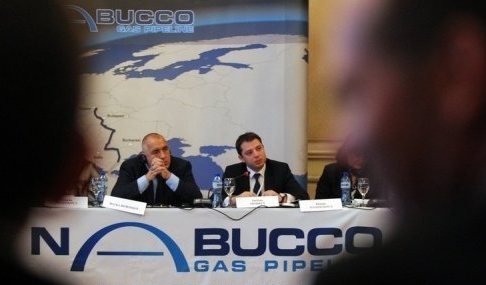
The Curtain Falls on Nabucco’s Last Act
Publication: Eurasia Daily Monitor Volume: 10 Issue: 123
By:

Nabucco-West, the pipeline project that was to have carried Azerbaijani gas from Turkey to the Central European Gas Hub near Vienna, is exiting from the stage. There will be no encore: “The Nabucco project is over for us. Our goal now is European gas for European customers,” Gerhard Roiss, CEO of Austrian OMV, the Nabucco consortium’s lead player, told the audience (Die Presse, June 27; and see accompanying article).
Nabucco’s rival Trans-Adriatic Pipeline project (TAP, Greece-Albania-Italy, led by Norwegian Statoil) has prevailed in the contest for priority access to Azerbaijani gas, eliminating Nabucco-West. On June 26, the gas producers’ consortium at Shah Deniz in Azerbaijan communicated this decision to the parties and to the European Union in Brussels (naturalgaseurope.com, accessed June 27).
Initiated in 2002, the Nabucco project held potentially winning cards of a strategic nature. Along with intrinsic comparative advantages, Nabucco long enjoyed the European Commission’s political and (unofficially) advisory support. Given this project’s superior potential, the Commission prioritized Nabucco as the mainstay of the planned Southern Gas Corridor to Europe. However, missteps in Vienna detracted from the project’s credibility, ultimately offsetting its advantages.
The proposed 3,900-kilometer pipeline, with a 56-inch (1,420-millimeter) diameter and an annual 31-billion-cubic-meter (bcm) design capacity, seemed moribund by 2011. The transportation project’s ambitions were outrunning the actual gas field development in the Caspian basin by many years. Consequently, Nabucco lacked supply sources and investment capital while facing steep cost increases for the project. The project company could not deal with these problems by citing outdated cost estimates, or by voicing wildly premature hopes to access gas from northern Iraq (a hope that could not even look optimistic since it presupposed a long, expensive connector pipeline). By 2011, Nabucco was losing credibility all around in its then-existing form (see EDM, January 31, 2012; February 3, 2012).
Outside the consortium’s official framework, OMV from time to time took some steps of its own that were inconsistent with the Nabucco project’s logic. At one stage, OMV attempted a hostile takeover of Hungarian MOL. When this failed, OMV sold its large package of MOL shares to Russian Surgut Neftegaz, which used it for its own hostile takeover attempt against MOL. At some stage, the Austrian side proposed allowing Gazprom to use part of Nabucco’s capacity in the future for Russian gas, which would have defeated this project’s supply diversification goals. While the Baumgarten terminal was a major selling point for Nabucco, OMV at one time agreed to share control of the terminal with Gazprom, until the European Commission invalidated that agreement.
In early 2012 Azerbaijan gave Nabucco a chance to survive in a more realistic form. Azerbaijan’s State Oil Company (SOCAR) initiated the Trans-Anatolia Pipeline Project (TANAP) to build the gas pipeline across Turkey to Europe, with Azerbaijan as main shareholder and project operator. TANAP, in effect, replaced Nabucco on Turkey’s territory, taking over the burden of responsibility for two thirds of Nabucco’s route.
This enabled the Nabucco company to reconfigure its project as Nabucco-West, from the Turkish-Bulgarian border to the continental gas hub at Baumgarten near Vienna. Its length now reduced to 1,300 kilometers, Nabucco-West looked more affordable and possibly bankable. The new version envisaged a 48-inch (1,220-millimeter) diameter pipeline, with a first-stage capacity of 10 billion cubic meters (bcm) per year, scalable to at least 23 bcm through additional looping. The first-stage capacity would equal the annual export volume from the Shah Deniz field to Europe, avoiding under-utilization of the pipeline. Subsequent capacity increases in Nabucco-West would have been correlated with gas field development in the Caspian basin (see EDM, May 23, 2012; June 29, 2012).
Yet the project’s reconfiguration did not address the consortium’s internal weaknesses. The Nabucco consortium should have included at least one major gas producer with experience in the Caspian basin. OMV, a medium-size gas trader and small-size producer, with no Caspian experience, did not fit that bill. The project consortium included six national gas trading and pipeline operating companies (Austrian OMV, Hungarian MOL’s unbundled subsidiary FGSZ, Romanian Transgaz, Bulgarian BEH’s subsidiary Bulgargaz, Turkish Botas, and German RWE, each of them holding 16.67 percent of the shares) during most of the project’s lifetime. RWE, financially the strongest partner, suffered heavy losses in its nuclear energy division following Germany’s decision to phase out nuclear energy, and had to disengage from Nabucco in 2012.
The project company repeatedly changed the main contractors for Nabucco’s front-end engineering and design (FEED). London-based Penspen had been in charge of supervising FEED work performed in the Nabucco countries by their respective engineering companies until 2011. Penspen was replaced by the Australian firm Worley Parsons to coordinate FEED work, as well as verify and review the project’s design. In January 2013, the Italian Saipem was chosen in a tender to perform a “re-FEED” for Nabucco-West, amid a corruption investigation of Saipem in Italy and the resignation of the company’s management. An Austrian company in Innsbruck became a subcontractor to Saipem (see EDM, March 26).
The continental gas hub at Baumgarten near Vienna was rightly viewed as a strong comparative advantage for Nabucco versus its rivals, including TAP. From Baumgarten, Azerbaijani gas could be distributed in several directions to lucrative markets. By late 2012–early 2013, however, those opportunities could be seen to diminish. With RWE withdrawing both from Nabucco and from the Czech pipeline system, Nabucco lost a guaranteed German customer and a possible connection with the Czech gas market from Baumgarten. At the same time, Bavaria’s gas trader Bayerngas abandoned negotiations on future gas purchases from Nabucco. Thus, in the short term at least, market opportunities for Azerbaijani gas northward and westward from Baumgarten were no longer in sight. Suddenly, the terminal seemed less attractive. This situation could well have changed with the market’s fluctuations, but not before the Shah Deniz gas producers including SOCAR decided to select TAP over Nabucco-West (see EDM, March 26, 27, June 27).
The “old” Nabucco project lost the European Commission’s strong political support by 2011. The reconfigured Nabucco-West did not seem to regain that support, at least not fully. Instead, the Commission moved toward equidistance between Nabucco-West and its European rivals, ultimately TAP. The United States, formerly a vocal supporter of the Nabucco project, seemed to lose focus on this project, and some of its earlier interest in the wider region.
Nabucco’s demise affects the politics of energy supply along the entire Southern Gas Corridor to Europe. As planned by the European Commission, the Corridor includes the gas producer, transit, and consumer countries situated between Turkmenistan and Central Europe. With Nabucco removed from consideration, planning will have to be revised in light of a post-Nabucco era.




